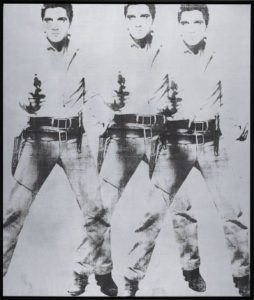There is a lot of talk stirring up the art world in anticipation for the upcoming sales of two Andy Warhol paintings, estimated to be worth up to $130 million for both. One of the paintings is Warhol’s, Triple Elvis (Ferus Type) , which features the king of rock and roll, Elvis Presley. The high value of this painting in particular can be attributed to the painting’s large dimensions, Warhol’s rare use of painting on canvas, and of course, the magnificent star power of the the painting’s subject and author.
Elvis Presley was one of Warhol’s earliest subjects, one in which he revisited several times throughout his career. In 1963, Warhol developed a twenty two piece series called Elvis for a solo show at The Ferus Gallery in Los Angeles, CA. He had been gaining momentum in his career after his Campbell’s Soup Cans show at the same gallery the year before.
The image used was one taken from a publicity still from the 1960’s film Flaming Star. In this photo, Elvis Presley is dressed as a cowboy with gun drawn, rather than the usual guitar in hand, revealing Warhol’s intent to depict Elvis as an actor, rather than to portray him as a musician.

This distinct choice to have a black image on a silver long strip could possibly be mimicking a film strip or “The silver screen”. Once all the images had been printed, he shipped the whole canvas along with a few different sized stretcher bars to Irving Blum in Los Angeles who cut the canvas and matched the images to the appropriate stretcher bars.
His only request be that the pieces would be placed directly next to each other, continuing with his repetitive style that had become his trademark. One critic said of this style:
“Toe to toe, repeated atop one another, poor Elvis becomes as thin and hazy as the idyllic illusion he publicly symbolizes; the assembly line produces the emptiness and sterility of soulless, over-managed puppetry.”
It is enticing to consider the critic’s analysis of Warhol’s Elvis as a comment that is equally applicable to Warhol’s persona. Paralleled are the stories and personas of two of Elvis Presley (“The King of Rock and Roll”) and Andy Warhol (“The Pope of Pop (Art)” two of the most significant pop culture icons of the twentieth century.

